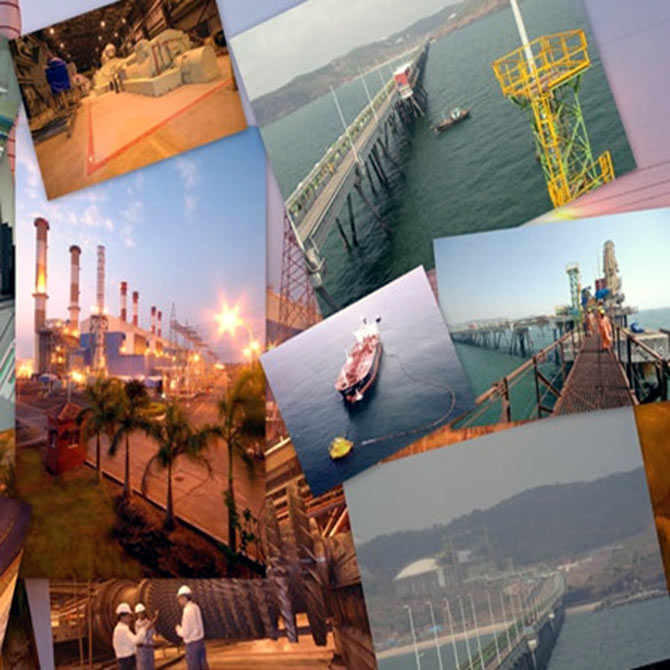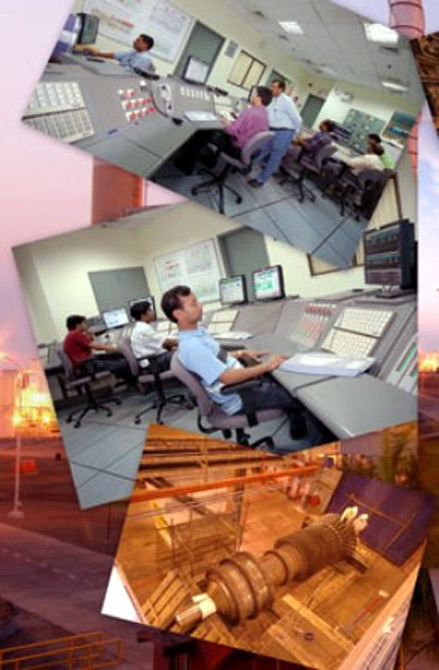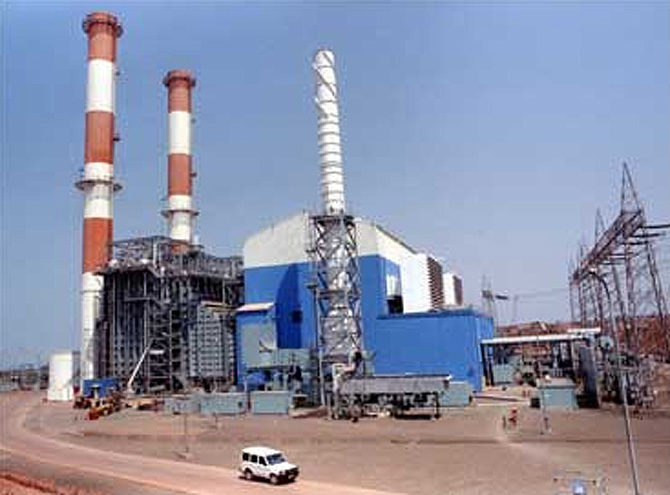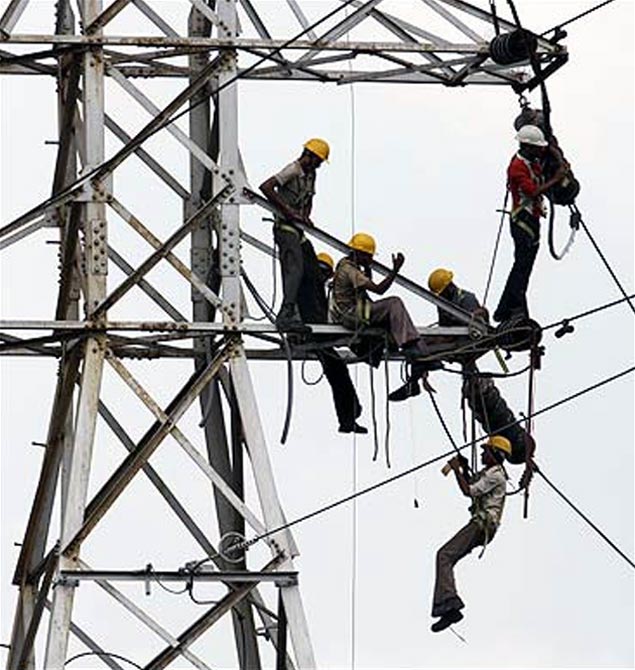 | « Back to article | Print this article |
At Dabhol, it's fight for survival all over again
Shutdown looms over the plant as severe gas shortages cripple production; company doesn’t have money to pay the monthly debt instalment of Rs 108 crore.
The Dabhol power plant is so identified with its infamous parent, Enron, that many still recall how the then US Assistant Secretary Christina B Rocca said India’s problems with foreign investment could be summed up in five letters: e-n-r-o-n.
Twelve years after being incarnated as a new company, the 1,967-Mw Dabhol project has its own three-letter problem: g-a-s.
Today, it is reeling due to non-availability of gas, with not even enough funds to service its monthly debt installment of Rs 108 crore (Rs 1.08 billion).
The default in the repayments has forced lenders led by ICICI Bank with an exposure of Rs 8,500 crore (Rs 85 billion) in the project to sound the alarm.
In July 2001, the celebrated power project was mothballed due to a dispute between the erstwhile Maharashtra State Electricity Board and the now defunct Dabhol Power Company.
It was revived in May 2006 as the Ratnagiri Gas & Power and was showcased as a successful turnaround, with banks and public sector companies joining hands to bring it on stream.
Now, ICICI Bank Managing Director Chanda Kochhar has dashed off a letter to Power Minister Jyotiraditya Scindia arguing strongly for an early restoration of gas supply for the power plant.
Click NEXT to read more...
At Dabhol, it's fight for survival all over again
“Lenders have sacrificed about Rs 2,500 crore (Rs 25 billion) at the time of asset takeover and also addressed (the requirement for) Rs 1,220 crore (Rs 12.20 billion) as completion cost at the time of restructuring in 2009,” Kochhar wrote in the letter.
Dabhol’s failure to repay its debts would make a deeper dent than its current outstandings. Kochhar says that the plant desperately needs gas supply to be restored to enable it to run at 85 per cent capacity so that it will be in a position to pay the loan installments.
ICICI Bank, IDBI Bank, State Bank of India and Canara Bank collectively hold 18.12 per cent equity in Ratnagiri Gas & Power. Of the rest, National Thermal Power Corporation and GAIL own 32.74 per cent each, while MSEB Holding Company owns 16.94 per cent.
The lenders have repeatedly expressed their displeasure at board meetings, and their dismay at the lack of action is quite apparent in Kocchar’s letter to the power ministry.
Ratnagiri Gas & Power requires around 8.5 million standard cubic metres per day (MMSCMD) of gas for full operation; the Centre made this allocation to the plant at its revival in 2006.
Of the allotted gas, 7.6 MMSCMD was from the KG-D6 Basin and the rest from the marginal gasfields of ONGC (through GAIL). But inconsistent availability of the assured gas has led to frequent closure, affecting both power generation and revenue. The plant has so far supplied around 48 billion units of power to Maharashtra.
Click NEXT to read more...
At Dabhol, it's fight for survival all over again
During 2011-12, Ratnagiri Gas & Power’s generation loss was 3,095 million units (MUs) worth Rs 1,150 crore (Rs 11.50 billion) mainly due to gas supply having dipped to an average 6.3 MMSCMD during the financial year.
Generation loss increased substantially to 8,387 MUs worth Rs 3,000 crore (Rs 30 billion) during 2012-13.
The gas situation, bad at best, has been debilitating after supply from KG-D6 was fully stopped on March 1, 2013 despite the plant having been accorded priority on par with the fertiliser sector by an Empowered Group of Ministers (no reason was given).
There was further trouble from August 15 onward when GAIL stopped its supply citing agreement issues. The generation loss in the current financial year, as of November 25, is a whopping 3700 MUs.
Costly supply
After the termination of gas supply, Ratnagiri Gas & Power has been generating power using naphtha, regasified liquefied natural gas (R-LNG) and domestic liquefied petroleum gas.
A potential shift to R-LNG for total generation has been strongly opposed by the state-run Maharashtra State Electricity Distribution Company (MahaVitaran), which procures 95 per cent power of its power from Dabhol.
The distribution company fears that the shift will lead to a rise in cost of power and subsequently to increase in power tariff. Currently, the cost of production is Rs 4-4.50 per unit using domestic gas.
Click NEXT to read more...
At Dabhol, it's fight for survival all over again
However, use of R-LNG is bound to increase the cost to Rs 8-9 per unit, which MahaVitaran has emphasised is not viable for its operations. The matter is currently caught in legal and regulatory exchanges.
Ratnagiri Gas & Power, in turn, has pointed out that MahaVitaran owes it around Rs 1,000 crore (Rs 10 billion) as arrears on date, of which about Rs 500 crore pertain to the period between April and July 15, 2013.
The company says that it has realised only around 25 per cent of the amount billed to MahaVitaran, a fact that is disputed by the distribution company.
A Ratnagiri Gas & Power spokesman admits that it is getting increasingly difficult for the power plant to remain afloat. “The company faces a realistic prospect of turning into a non-performing asset for the lenders by December this year, unless another Rs 200 crore is inducted immediately,” he says.
NPA classification this month was staved off by MahaVitaran releasing a part of its payment, facilitating the payment of Ratnagiri Gas & Power’s September loan installment.
Click NEXT to read more...
At Dabhol, it's fight for survival all over again
Debt woes
“Ratnagiri Gas & Power does not have the financial strength nor security mechanisms and is vulnerable in the absence of support from the Centre,” says the spokesperson.
“The resolution of the current crisis requires convergence of the competing interests of stake holders, especially the Maharashtra government and the distribution undertaking.” The power company is first approaching the central and state governments to arrange for the required gas volumes, before embarking on taking “any surgical options to raise funds, which remain options of last choice”, according to the spokesperson.
In addition, Ratnagiri Gas & Power has insisted that the Maharashtra government take a proactive role in overturning the crisis. “The promoters and institutions that had supported the Maharashtra government in its effort to restart the plant may find it difficult to endlessly support the company in the absence of synergy with the state government,” says the spokesperson.
The Dabhol management had met Maharashtra Chief Minister Prithviraj Chavan on viability concerns and sought his help in the restoration of gas and in payment of fixed cost and dues against power supplied.
On its part, while the Congress-Nationalist Congress Party government has sought the Centre’s mediation in resolving the crisis, there is growing agreement within the ruling coalition that the Centre should take over the project, with the power generated being pooled. But, more pertinently, the state is opposed to any attempt to hand over the project to the private sector.
Power Problems
* The generation loss in the current financial year up to November 25 is about 3,700 million units
* RGPPL’s move to use R-LNG as fuel is opposed by MahaVitaran because it will increase per unit tariff to Rs 8-9 from Rs 4.450 now
* RGPPL faces a realistic prospect of turning into an NPA by December 2013 unless another Rs 200 crore is infused into the company
* Rs 8,500 crore is the outstanding debt on its books
* Lenders make a strong case for an early restoration of gas supply to run the project at 85 per cent capacity
* Maharashtra government seeks PM’s intervention





